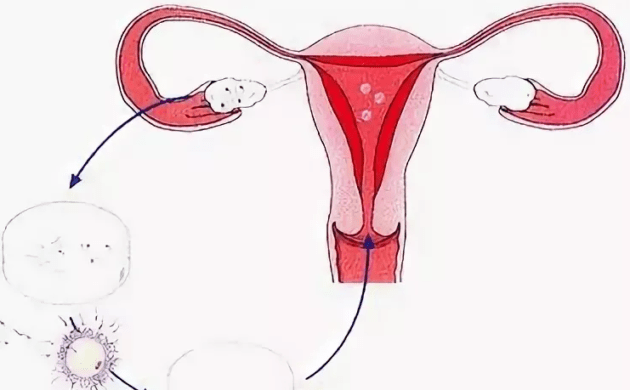Content
- 1 What is and classification of amenorrhea in girls
- 2 Causes of primary, secondary amenorrhea in adolescents
- 3 Symptoms of amenorrhea in adolescents
- 4 Diagnosis of amenorrhea in adolescents
- 5 How to treat amenorrhea in teenage girls
- 6 Preventive measures and forecasts
- 7 Conclusion
Among the possible pathologies of the reproductive system in girls, amenorrhea, which is expressed in the absence of menstruation, is not the last. This phenomenon is not usually considered a disease, in addition, it does not mean future infertility. Nevertheless, the treatment of amenorrhea in adolescents is widespread in modern gynecological practice.
What is and classification of amenorrhea in girls
Since amenorrhea is the absence of timely menstruation, its occurrence indicates that the girl's reproductive system has not reached puberty by age. The beginning of the reproductive period of the future woman falls on the age of 9-12 years, this is usually marked by the appearance of the first menstruation, called menarche. In girls with low weight, it can linger up to 13-14 years.
The absence of menstruation before the age of 16 is also the norm. If menstruation does not occur after this age, it is customary to speak of amenorrhea.

If there are no visible or pathological reasons for the absence of menstruation in a girl at the age of 16, this is a reason to visit a gynecologist
In gynecological practice, there are two types of amenorrhea:
- primary;
- secondary.
Between them there is a difference not only in the causes, but also in the methods of treatment, as well as in the forecasts for the further development of the reproductive system.
The prevalence of primary amenorrhea is only 0.1% among all girls aged 15-16 years. A secondary type of disease is considered if the teenager has already had menstruation, and even a cycle has been established. But then regular periods stopped for no apparent reason.
The following signs indicate secondary amenorrhea:
- Before the absence of menstruation, the cycle was more or less stable, no special disturbances were observed in its course.
- The menstrual cycle was present, but was disturbed. This also includes the absence of menstruation for six months.
A warning! According to studies, the causes of secondary amenorrhea are often lack of sleep and various psychological factors.
Causes of primary, secondary amenorrhea in adolescents
The conditions that cause secondary or primary amenorrhea in adolescents are different. However, there are also common reasons for the absence of menstruation:
- changes and disorders at the level of the chromosome set;
- surgical intervention in the reproductive system of a girl, which was carried out at an early age;
- congenital deformity or pathology of the genital organs of a teenager;
- the presence of harmful factors during pregnancy that influenced the mother.
When contacting the doctor, it is mandatory to collect an anamnesis, in which it is often possible to identify causes related to the hereditary factor. If someone in the female line in the family suffered from primary or secondary amenorrhea, it can be passed on to a teenager. At this stage, it is the genetic causes of a sharp violation of the cycle that are identified. These include:
- Turner's disease is a chromosomal disorder, which is a pathology of physical development.
- Congenital malformations.
- High testosterone levels caused by androgen insensitivity.
As the causes of the secondary type of the disease, it is customary to consider:
- diseases of any internal organs;
- gynecological pathologies;
- increased physical activity, including professional sports;
- a small amount of weight that does not correspond to age, anorexia.
Important! Any genetic abnormality is recommended to be considered as the cause of amenorrhea.

Secondary amenorrhea is widespread among girls who run professionally.
Taking certain medications can lead to stopping menstruation:
- hormones;
- neuroleptics;
- antihistamines;
- antidepressants;
- drugs from the chemotherapy group.
In the presence of disorders in the endocrine system, the cycle may be absent initially.
Symptoms of amenorrhea in adolescents
The main symptom of amenorrhea is the absence of menstruation. Other signs of violations of the girl's reproductive system may be added to this:
- weight loss;
- hair loss;
- changes in the visual apparatus.
Due to the jump in testosterone, which often becomes a violation of the cycle, unwanted hair can appear on the body.
Diagnosis of amenorrhea in adolescents
Before the treatment of cycle disorders, an important point is the correct diagnosis. Not always amenorrhea can be the cause of failures. The initial examination includes a mandatory conversation between the doctor and the patient in order to collect a family history.
This is followed by laboratory and instrumental diagnostic methods. First you need to donate blood to determine the level of the following hormones in the girl's body:
- luteinizing;
- follicle-stimulating;
- thyrotropic.
This analysis is mandatory if the girl does not have menstruation at the age of 16, and the menarche has never occurred.
Secondary amenorrhea requires a wider diagnosis:
- pregnancy test;
- study of the level of a number of other hormones in the body;
- checking the functioning of the thyroid gland.
Important! The doctor should also take into account the lifestyle of the teenager, his diet and the presence of physical activity.
In secondary amenorrhea, ultrasound will be informative, as well as sampling for the state of the hormonal system. If a pituitary tumor is suspected, an MRI of the brain is necessary.
How to treat amenorrhea in teenage girls
Clinical recommendations for amenorrhea in adolescents provide for mandatory therapy for both primary and secondary forms. The tactics of treatment in any case is determined by the reasons that caused the disruption of the reproductive and reproductive system of a teenager.
If primary amenorrhea is caused by any physiological pathology, surgery may be required. With the secondary, an integrated approach is always required:
- body weight control;
- revision of lifestyle;
- return of hormonal balance in the body, etc.
If the disease is caused by a hormonal imbalance, appropriate drugs are prescribed to help quickly restore the cycle. In 40% of cases, it is possible to return the menstrual cycle with the help of non-aggressive means - vitamin therapy, physiological procedures. However, this is possible only if the pathology is caused exclusively by the girl's lifestyle and does not have chromosomal causes.

In some cases, the cause of secondary amenorrhea is a pregnancy that the teenager does not know about.
Preventive measures and forecasts
The prognosis for primary and secondary amenorrhea is usually favorable. But at the same time, it directly depends on the reasons that caused the imbalance in the body of a teenager. It is important to identify the disease in time and take the necessary measures.
As for prevention, as such methods in this direction in gynecological practice have not been identified. The main thing is to track the menstrual cycle and be sure to consult a doctor if menarche does not occur before the age of 16.
If we talk about non-specific methods of prevention, then these include:
- control of body weight and nutrition;
- refusal of excessive physical exertion;
- refusal to intervene in the organs of the reproductive system, if there are no mandatory indications for this;
- maintaining a healthy lifestyle.
A warning! If you suspect the presence of endocrine diseases at an early age, you should immediately consult a doctor.
Conclusion
The treatment of amenorrhea in a teenager depends on the reasons that caused the violation of the cycle or the complete absence of menarche before the age of 16. If menstruation is absent for no apparent reason and prior interventions in the reproductive and reproductive system of a girl, this is a reason to consult a doctor to exclude or confirm diagnosis.
The information and materials on this site are provided for informational purposes only. You should not rely on the information as a substitute for actual professional medical advice, assistance or treatment.
